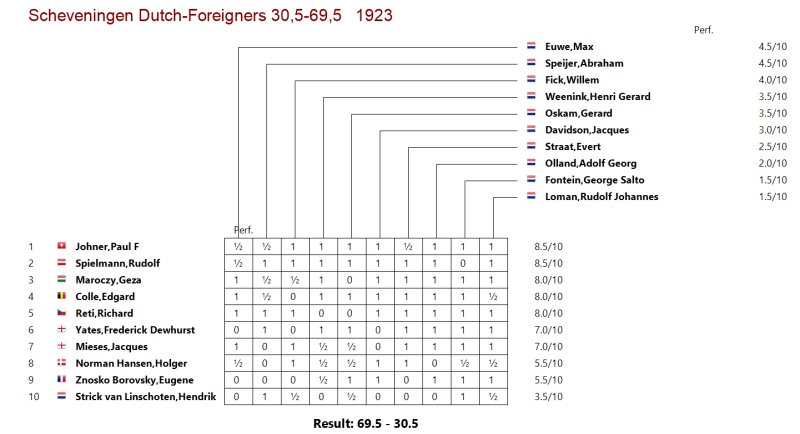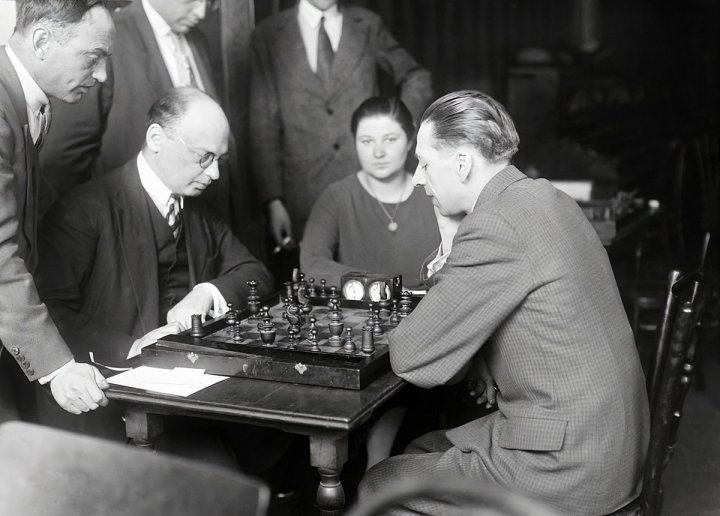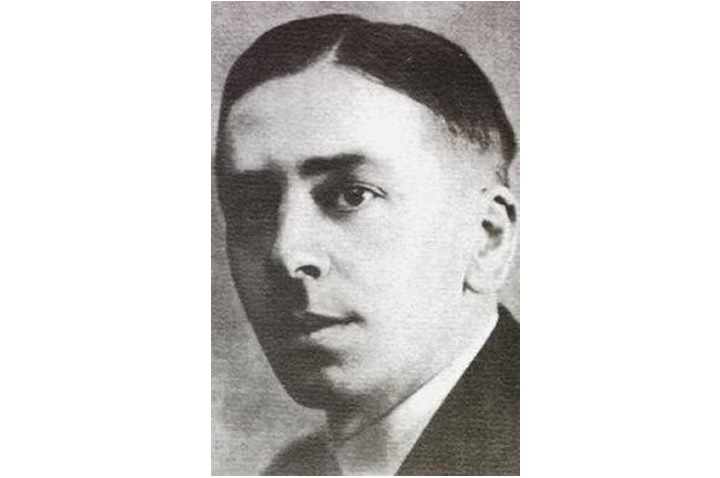Remembering Edgard Colle
Colle was a multiple Belgian national champion who participated in the strongest international tournaments of the 1920s, winning several of them. His contributions certainly extend beyond the opening he popularized, and he deserves far more recognition than he has been given today.
Information on Colle's early life is very scant, and not much is known about his family, childhood, religion, and education. Between his birth in Ghent, Belgium on May 18, 1897, and his death there on April 19, 1932, however, his chess career is very well-documented.
Colle's earliest successes came when he won the Ghent championships of 1917 and 1918. Beginning 1918, he was known to frequent the Le Cercle des Echecs de Bruxelles, where he trained with the Belgian master Max Nebel.
Colle had likely gone through trying times in this period of his life. Since the 1900s, tension had been building among Europe's superpowers - Britain, France, Russia, and Germany - until World War I erupted in 1914. In 1914, Germany violated Belgium's neutrality and advanced through the country. To suppress civilian resistance, the Germans adopted a policy of terror. By the time France and Britain halted the advance, most of Belgium was under German forces, and would remain so until late 1918.
The Germans were particularly hard on Ghent. They quartered about 12,000 troops there, and conscripted nearly 12,000 men for forced labor. They shut down factories, took away food, limited travel, took usable metal from the city, limited press freedom, looted churches and museums, and executed suspected spies. Thousands in Ghent would have starved if food from overseas were not shipped. In February 1917, there was also an outbreak of the flu. Colle was around 20 then, and it is safe to assume he was not one of the men conscripted or taken ill, otherwise he would not have become Ghent's champion.
.jpg)
Alexander Alekhine (left) vs Edgard Colle, 1925 | Photo: Wikipedia
International chess had stalled, but after the war's end in November 1918, it revved up again. Many prominent chess masters of the pre-war era would either pass away, like Carl Schlechter, or retire from competition, including Dawid Janowski, Siegbert Tarrasch, Jacques Mieses, Richard Teichmann, Ossip Bernstein, George Marco, Amos Burn, and Oldrich Duras. Still others, such as Akiba Rubinstein, Rudolf Spielmann, Richard Reti, Frank Marshall, Savielly Tartakower, and Milan Vidmar resumed where they had left off.
Less than three years later, Jose Raul Capablanca dethroned Emanuel Lasker, who held the title since 1894. Owing to the development of technique and the expansion of theory, the new world champion regretted the "death of the draw." Young players like Aron Nimzovitsch, Gyula Breyer, Ernst Gruenfeld, and Reti, however, challenged the classical school with their Hypermodern ideas. Their novel and strategic approach to the opening proved that chess was far more complex than previously imagined.
It was against this backdrop that Colle began his international career. Chess was entering its golden age, and Colle would figure heavily in the clash of modern, great masters.
Colle's first impressive performance came in Scheveningen 1923, an event organized to commemorate the 50th anniversary of the Royal Dutch Chess Federation. Colle was one of the nine foreigners pitted against eleven Dutch masters. He tied for second place with Maroczy and Reti, trailing behind Spielmann and Paul Johner. He was, however, ahead of Frederick Yates, Eugene Znosko-Borovsky, and Max Euwe.

As a new competitor, Colle's style was as striking as his result. Just when Capablanca thought chess was all exhausted, Colle came out with a highly dynamic, attacking style. He played exciting chess, which made him a favorite of tournament organizers. Thereafter, he became a very prolific international tournament player.
Colle's performance at Scheveningen 1923 marked him as a man with a future. He did not climb the ranks immediately, but eventually met expectations and demonstrated consistent progress throughout the decade, as his following results showed:
- Hastings 1923-24: 3rd place with Frederick Yates (behind Maroczy and Euwe)
- Meran 1924: 7th place with Opocensky (behind Gruenfeld, Spielmann, and Reti, Alexey Selesnieff, David Przepiorka, Sandor Takacs, but ahead of Tarrasch and George Koltanowski)
- Hastings 1925-26: 5th place with Yates (behind Alexander Alekhine and Vidmar, but ahead of Janowski)
- Weston-Super-Mare 1926: 2nd place (behind Euwe)
- Amsterdam 1926: 1st place (tied with Euwe, Tartakower, and Johannes Pannekoek)
- Scarborough 1926: 1st place (ahead of Jakob Seitz and Znosko-Borovsky)
- Budapest 1926: 7th place with Reti (behind Kmoch, Rubinstein, Takacs, but ahead of Tartakower, Yates, and Znosko-Borovsky).
- Bardejov 1926: 4th place (behind Herman Mattison, Tartakower, and Lajos Asztaloz, but ahead of Boris Kostic)
- Ghent 1926: 3rd with Janowski (behind Tartakower and Yates)
- Meran 1926: 1st place
Meran 1926 was the highlight of Colle's early career. In the meanwhile, he was also dominant at home. He was Belgian champion except for a short period when he lost the title to George Koltanowski, but regained it in 1924. In 1925, he defeated Koltanowski anew, 4-0.
Meran 1926, Final standings after 13 rounds
With his result in Meran, one might have expected Colle to soon become one of the world's leading players, but it was not to be. He suffered from a gastric ulcer, which very often caused him stomach pain and hampered his performance. He continued scoring successes but sometimes faltered because of his poor health. His most important results after 1926 were:
- Hastings 1926-27: 2nd place (behind Tartakower, but ahead of Reti and Yates)
- Scarborough 1927: 1st place (ahead of Yates and George Thomas)
- Bad Niendorf: 3rd place (behind Nimzovitsch and Tartakower, but ahead of Ahues, Kostic, Kmoch and Lajos Steiner)
- Hastings 1927-28: 3rd place (tied with Victor Buerger, behind Tartakower and Steiner)
- Scarborough 1928: 2nd place (behind William Winter, but ahead of Bogolubov)
- Hastings 1928-29: 1st place (tied with Marshall)
- Carlsbad 1929: 12th place in a very strong field that included Vidmar, Spielmann, Maroczy, Tartakower, Thomas, Rubinstein, Bogoljubov, Yates, Nimzovitsch, Capablanca, Gruenfeld, Marshall, and Fritz Samisch
- Barcelona 1929: 3rd place (behind Capablanca and Tartakower)
Hastings 1928-29, Final standings after 9 rounds
In these last three events, Colle was struggling with his illness.
- San Remo 1930: 11th place (participants included Alekhine, Nimzovitsch, Rubinstein, Bogoljubov, Yates, Spielmann, Vidmar, Maroczy, and Tartakower)
- Scarborough 1930: 1st place
- Liege 1930: 3rd place with Nimzovitsch (behind Tartakower and Sultan Khan, but ahead of Rubinstein, Thomas, and Marshall)
- Frankfurt 1930: 5th place (behind Nimzovitsch, Kashdan, Ahues, but ahead of Przepiorka, Vasja Pirc, Saemisch, Mieses, and Thomas
- Bled 1931: 12th place
- Rotterdam 1931: 2nd place (in a tie with Salo Landau, Tartakower, and Rubinstein)
Scarborough 1930 - Final standings
Around 1925, Colle popularized the opening that now bears his name. With his attacking style, he turned the opening into a weapon and won many fine games with it. Later, his Belgian friend and rival, Koltanowski, adopted the opening in his honor. Koltanowski wrote several books on the opening, which later came to be known as the Colle-Koltanowski. Koltanowski remained faithful to it throughout his long career.

Paris 1929: Edgard Colle (right) vs Savielly Tartakower, Vera Menchik kibitzes | Photo:
On April 19, 1932, Colle passed away after undergoing a fourth surgery for his ailment, about a month before his 35th birthday.
In 1924, Colle and Euwe played a match of eight games, after which the two players became very good friends. After Colle's death, the future world champion wrote a memorial to Colle entitled Gedenkboek Colle. It is a touching tribute to Colle that offers glimpses into his character. Euwe wrote:
"It was in Zutphen, April 1924, that I got to know Colle better. We had been friendly with each other from the first time we met, but our dealings were merely those of superficial pleasantries. In Zutphen, we played a match of eight games with an unusual score line. We each won every other game, always with white. After seven games I was leading 4-3, meaning the eight game, in which I was Black, would decide the outcome. With a pawn sacrifice, Colle started a dangerous kingside attack that required my utmost attention to prevent a catastrophe. Since we were playing away from the public, and even the arbiter would only drop in occasionally just to relay the moves to the demonstration board, Colle and I would frequently engage in conversation, not only about chess. I have forgotten whether I asked for his evaluation of a particular position, but I remember that he expressed an opinion - as always optimistic and honest - that he considered his position to be easily winning. Colle's opinion provoked me more than I can remember, not only because I disagreed, but because of the great confidence with which it was proclaimed. I found his assertion that I had not a single chance of counter-play rather presumptuous at the time.
Even though Colle was five years my senior, having had a longer chess career than him, I thought it was my duty to point out to my friend and foe that he was mistaken. I told him that if he keeps underestimating his opponents' resources like he did with me, he won't become a great player. I was straightforward. We continued the game and Colle lost quickly. Probably he lost his bearings as a result of my unexpected rebuttal, as in our analysis afterward it turned out the critical position was indeed winning for him. As it seems to me, I had, although unintentionally, upset him so much it caused Colle to lose the game. Colle could justly have complained that I had distracted him from the truth of the position with an incorrect evaluation.
But Colle did not do this. He was a person of high quality who took my words to heart, even though they had been offered in a manner that was anything but appropriate. Moreover, he thanked me for my well-intended remarks and said he would be more careful in his evaluations henceforth! It was an unforgettable moment. I then realized I was in the presence of a man of truly great character, far above the stature of the average man. Chess players will be able to relate to this episode, accepting defeat in spite of a good reason to dispute the loss. At that moment Colle and I became very good friends."
In Gedenkboek Colle, Euwe shared that Colle started as a positional player who studied thoroughly the games of Wilhelm Steinitz. He would exploit slight advantages and grind opponents down. Owing to his ailment, however, he lost patience and stamina for slow play. He veered away from his positional style until the old Colle became almost unrecognizable. Euwe revealed:
One would barely recognize Colle as in most of his games there was a certain vitality, seemingly devoid of scientific, dry positional play. Colle was adventurous and lacked the patience of a cat, waiting for hours for a mouse to appear from its lair. He aimed for lively play full of romance, a fast and furious win, or loss, even though he had shown he had fully mastered a calm and quiet approach.
.png)
Rotterdam 1930: Edgard Colle (right, with White) vs Efim Bogoljubov | Photo: tirismedia.net
Many of Colle's games were double-edged, where the advantage swung like a pendulum. In his book, Edgard Colle - Caissa's Wounded Warrior, Taylor Kingston likens them to a slugfest.
"Rather than the machine-like inevitability of flawless strategic masterpieces, these games show imperfect yet very human, gutsy, courageous, resourceful chess where the players are like boxers trading blows, each getting knocked down but coming off the mat to continue the fight to the last round."
The Austrian-Dutch-American player, journalist and author, Hans Kmoch, was another one of Colle's friends. He also penned a tribute to Colle, where he remembered the Belgian master as a tenacious player who bore his illness with stoicism. Kmoch wrote:
Colle was not sentimental. He bore his suffering as something quite private and of minor importance. He asked for no special consideration; he was always cheerful and confident, a charming companion; but at the chessboard he was an unrelenting fighter who had an exemplary sporting spirit and sense of duty. Every game was fought stubbornly. Lengthy, difficult, tiring games were part of his style. Only his tremendous willpower carried him through these games. His spirit ruled his body.
Colle follows Rudolf Charousek, Harry Nelson Pillsbury, and Carl August Walbrodt as very promising masters who passed away young, and before fulfilling their potential. One could only imagine how much more he could have accomplished and how far he could have gone, perhaps even contend for the world championship, had his illness not cut his life short.
The Colle System, with 1.d4 followed by 2.Nf3 and 3.e3 is an unpretentious set-up for White but one which contains considerable venom. White’s pieces can suddenly be unleashed to create devastating attacks, as can be seen in the games of Artur Yusupov, Evgeny Bareev, Vlatko Kovacevic and others. The Colle also has many practical advantages in that it doesn’t require much theoretical knowledge and can throw people on their own resources. For all these reasons it is an excellent choice for players at club level and beyond. On this DVD Davies explains the various plans and ideas at White’s disposal. Whilst his main recommendation is to play 3.e3 after 1.d4 Nf6 2.Nf3 e6 and 1.d4 d5 2.Nf3 Nf6, he also shows how it can be made into a viable system against the King’s Indian, Benoni and Dutch Defences.
References:
Taylor, Kingston. The Fighting Chess of Edgard Colle - Caissa's Wounded Warrior. Millford, CT USA: Russell Enterprises, Inc., 2021.
Wikipedia. 2022. “Edgard Colle.” Last modified October 11, 2022.
https://en.wikipedia.org/wiki/Edgard_Colle
Games
Colle vs. O'Hanlon, Nice 1930 – One of Colle's most famous and anthologized games, out of the opening that he popularized. Colle's combination may have led to no more than a draw, but his opponent's error allows a brilliant finish.
Colle vs. Gruenfeld, Berlin 1926 – Colle's immortal, evergreen game, this time from a variation (the Colle-Zukertort System) of his pet opening.
Spielmann vs. Colle, Dortmund 1928 – A game that won the first brilliancy prize. Colle comes out on top in this battle between formidable tacticians.
Colle vs. Euwe, Scheveningen 1923 – Colle scores a sparkling win in his first encounter with the future world champion.
Colle vs. Bogoljubov, San Remo 1930 – Colle defeats a world title contender in another fine attacking game.
Rubinstein vs. Colle, Rotterdam 1931 – Colle's attack overwhelms the great Polish master. This is the last tournament game the two competitors ever played.
Links
See more articles by Eugene Manlapao...


















.jpg)


.png)





